| Reviews & Columns |
|
Reviews DVD TV on DVD Blu-ray 4K UHD International DVDs In Theaters Reviews by Studio Video Games Features Collector Series DVDs Easter Egg Database Interviews DVD Talk Radio Feature Articles Columns Anime Talk DVD Savant Horror DVDs The M.O.D. Squad Art House HD Talk Silent DVD
|
DVD Talk Forum |
|
|
| Resources |
|
DVD Price Search Customer Service #'s RCE Info Links |
|
Columns
|
|
|
Forbidden Planet
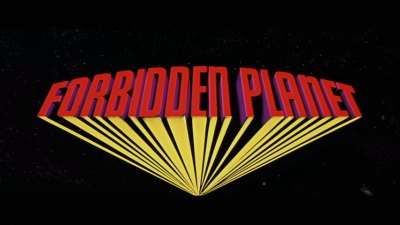
The SF films of the 50's are often dismissed on whole as low budget drive-in fodder made by the likes of Roger Corman to turn a quick buck. While that is true to a large extent it isn't entirely accurate. There were a handful of excellent SF films made at that time including Destination Moon (1950) and The Day the Earth Stood Still (1951). One of the best and the film that set the high mark for SF for decades to follow is Forbidden Planet (1956). An imaginative and influential film, Warner has restored this classic and released it both as a two disc set and in an Ultimate Collector's Edition which has some neat bonus items.
The United Planets cruiser C-57D has been assigned the task of checking on the scientific expedition that settled the planet Altair 4. Nothing has been heard from the group since they landed 20 years ago.
 When they arrive at the planet, radio contact is made with the expedition and Morbius (Walter Pidgeon) mysteriously warns the ship away. He says that everything is fine, but if the ship lands, he can't be responsible for their safety. Commander J. J. Adams (Leslie Nielsen) isn't scared off so easily, and places the ship down.
When they arrive at the planet, radio contact is made with the expedition and Morbius (Walter Pidgeon) mysteriously warns the ship away. He says that everything is fine, but if the ship lands, he can't be responsible for their safety. Commander J. J. Adams (Leslie Nielsen) isn't scared off so easily, and places the ship down.
The crew of the C-57D is surprised when a Robot, named Robbie, arrives and offers to ferry a team to meet Morbius. Doc Ostrow (Warren Stevens) and Lieutenant Farman (Jack Kelly) accompany Commander Adams to Morbius' compound. There they discover the scientist living alone except for his lovely daughter Altaira (Anne Francis). Morbius explains that the rest of his group was attacked after they voted to go back to Earth. One by one an invisible monster tore the other members of the party limb from limb. Only he and his wife, who died of natural causes after giving birth to their daughter, were spared. The creature hasn't returned since.
Even though he and his daughter are alone, Morbius refuses to go back to Earth. Adams isn't sure what to do, so he instructs his men to cannibalize parts of the ship in order to create a radio that will reach headquarters so he can get new orders. That night, an invisible creature sneaks aboard the ship and wrecks some of the transmitting equipment.
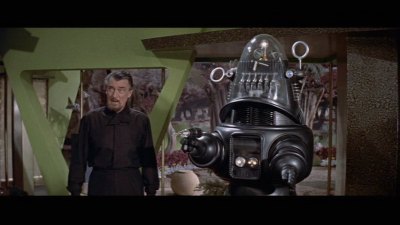 Suspecting Morbius of the sabotage, Adams returns the next morning and discovers why the scientist doesn't want to leave. Deep under the ground of Altair 4 lay the remains of an alien civilization, the Krell. Much more advanced than humans, the Krell were on the brink of a great discovery when suddenly they all disappeared. Morbius has been working for the past 20 years to solve the mystery of what happened to the Krell and unravel their advanced technology. When Adams insists that the discoveries he's made be turned over to the United Planets, Morbius refuses and that night the invisible monster attacks again.
Suspecting Morbius of the sabotage, Adams returns the next morning and discovers why the scientist doesn't want to leave. Deep under the ground of Altair 4 lay the remains of an alien civilization, the Krell. Much more advanced than humans, the Krell were on the brink of a great discovery when suddenly they all disappeared. Morbius has been working for the past 20 years to solve the mystery of what happened to the Krell and unravel their advanced technology. When Adams insists that the discoveries he's made be turned over to the United Planets, Morbius refuses and that night the invisible monster attacks again.
One of the most amazing things about Forbidden Planet is that it shouldn't be as good as it is. There were a lot of things working against the film, but it rises above these limitations. Like Casablanca, where teams of writers were working on the script as it was being filmed, a sheer receipt for disaster, Forbidden Planet had several problems to overcome.
The movie was conceived by Allen Adler and Irving Block, who were hoping to sell it to a low budget studio. They made a pitch to MGM though, one of the biggest studios in Hollywood at the time, and found success. MGM wasn't in the SF film business, they made more important films, but the execs at the studio realized that SF was popular and they wanted to cash in on the fad.
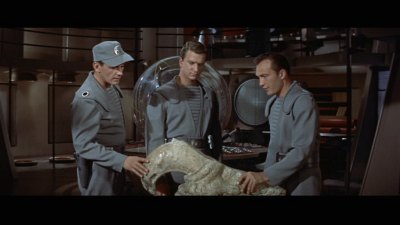 Fred M. Wilcox was assigned to direct. He had worked his way up through the studio system, his first assignment directing was to film screen tests for MGM hopefuls, and has directed a few Lassie films as well as some B-pictures like Code Two, about motorcycle cops, and the boxing film The Tennessee Champ. He wasn't the best director for such an imaginative picture. His directing is solid but uninspired, and it does nothing to enhance the film. The performances that Wilcox gets from the cast are a bit dated by today's standards. The actors come across as a bit stiff and lifeless.
Fred M. Wilcox was assigned to direct. He had worked his way up through the studio system, his first assignment directing was to film screen tests for MGM hopefuls, and has directed a few Lassie films as well as some B-pictures like Code Two, about motorcycle cops, and the boxing film The Tennessee Champ. He wasn't the best director for such an imaginative picture. His directing is solid but uninspired, and it does nothing to enhance the film. The performances that Wilcox gets from the cast are a bit dated by today's standards. The actors come across as a bit stiff and lifeless.
The script wasn't perfect either. For some reason a comic relief was added in the form of the ship's cook (Earl Holliman) and it doesn't work at all, with some of the comedy even being a bit embarrassing. The humor is timed poorly and it doesn't fit in with the rest of the movie. When Robbie burps after 'analyzing' the last of the cook's whiskey, it makes viewers scratch their heads more than laugh. Some plot points aren't explained either. For example, Altaira dreams that the ship is being attacked by the invisible monster while it actually is being attacked. How did she know that? Was it some sort of psychic effect? It's never explained.
The version of Forbidden Planet that was released was actually just a rough work cut. The film's editor, Ferris Webster, put together a first edit and the producers were unsure about the Theramin based music track. They sent the print to a theater for a sneak peak and the reaction was so strong that the studio released it as it was. Webster fought to be able to finish editing the film, but MGM didn't see any reason to.
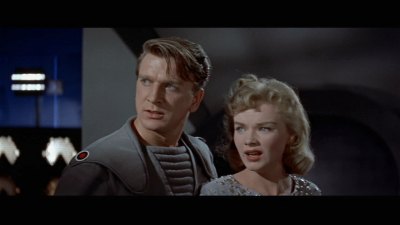 On top of all of this, MGM didn't know how to market the film. They created a one sheet movie poster that had Robbie carrying an unconscious Anne Francis, with her underwear showing no less. This was an attempt to cash in on the SF monster films that were making the rounds in those days. It never occurred to the people in charge that this film was much superior to those z-grade films and should be marketed differently.
On top of all of this, MGM didn't know how to market the film. They created a one sheet movie poster that had Robbie carrying an unconscious Anne Francis, with her underwear showing no less. This was an attempt to cash in on the SF monster films that were making the rounds in those days. It never occurred to the people in charge that this film was much superior to those z-grade films and should be marketed differently.
So, if this film has mediocre acting, a flawed script and is a rough edit, why is it a considered a classic? For all of the things that it gets right. This isn't a space opera; it is a SF film that really has some interesting concepts behind it, and developed them well. The mystery of just what is attacking the space ship works well, and the answer is rather surprising and very sophisticated when compared to other SF films of the times.
The special effects are also top notch for the times. The Krell city doesn't only look good, it is done on such a huge scale that it is breathtaking. The 7800 level machine that plunges miles and miles into the crust of the planet is truly impressive.
If there is one aspect of the film that works better than the others however, it is the fact that the film is set in what author Bill Warren calls a "logical future". Like Star Trek, which was heavily influenced by this movie, the crew of the space cruiser doesn't make a big deal over technology that is common to them, but advanced for a 1950's audience. When Adams checks in with the ship the first time he visits Morbius, he scans the area with a small movie camera the size of a pen. It's a natural reaction that doesn't cause a lot of comment. Likewise with the force fields and ray gun blasters that are employed. They eschew labeling everything with "space" or "Earth" too. No one ever says "We'll meet you in ten Earth minutes by the space car." The future that this movie paints is one that has developed over time and the way people act in respect to their technology is sensible. That is what makes this film so enjoyable.
The Ultimate Collector's Edition of this film comes with some nice goodies. First of all is the movie, presented in a two disc set with copious extras. (See below.) There's also a series of postcard sized lobby card reproductions, a coupon for a "free" repo full sized movie poster that costs $3.25 for S&H as well as a UPC from the package. There is also a small plastic Robbie the Robot toy that's about 3" tall. It doesn't move, but it's still pretty neat. All this is housed in a nice red tin with an embossed cover.
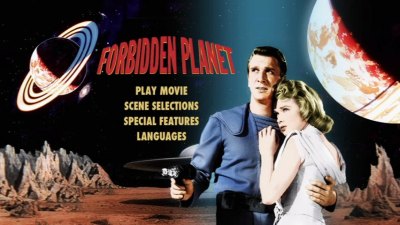
Audio:
This movie comes with a newly remastered DD 5.1 soundtrack. I was a bit disappointed to discover that the original mono track wasn't included. Being a purist, I'd like to at least have the option of viewing the movie the way it was originally intended to be seen. The Dolby mix sound good however, with a limited dynamic range which is to be expected for a film of this age, but little in the way of audio defects. Given the age of the film I didn't expect too much in the way of low bass and I wasn't surprised, and the surround channels don't get too much action. Still, this is a good, clean sounding disc.
Video:
The anamorphic 2.35:1 widescreen image looks great. The restored picture really does the film justice. The film was shot on Eastman Color film stock, a type of film that is infamous for easily fading. The technicians at Warner have boosted the colors to recreate the original look of the film and they generally look very good. In some scenes some objects appear to have a 'plastic' sheen to them, Leslie Nielsen's hair for instance in the early shots aboard the ship, but this is minor. There is still some minor aliasing and closely spaced lines, such as those on Robbie's 'mouth' tend to jiggle as the camera pans over them. Black levels are solid and the contrast is fine. Details are generally sharp even in shadows. This is the best I've seen this film look. The disc is also available in HD DVD. You can read Adam Tyner's review of that version here.
Extras:
This two disc set is chocked full of extras. On the first disc there are a series of deleted scenes which are fun to watch but don't add much to the film, and some "lost" footage of special effects that weren't used in the final release. The two excerpts from MGM Parade, hosted by Walter Pidgeon are an interesting addition. These promotional pieces were filmed especially for the show and are an interesting bit of film history. The first disc wraps up with seven theatrical trailers and an episode of the Thin Man TV show staring Peter Lawford and Phylis Kirk as the crime solving couple. The episode included features Robbie the Robot.
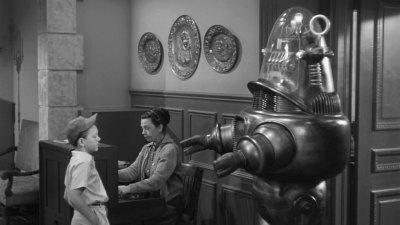 Disc two starts of with another MGM movie that features the robot from Forbidden Planet, The Invisible Boy. I was pleasantly surprised to find that this film has also been restored also, and probably deserves its own release. This film, tenuously linked to Forbidden Planet, involves a boy who, with the help of a supercomputer, reassembles a robot (Robbie) that had been brought back through time. While this film is more juvenile in nature, it has a lot of charm.
Disc two starts of with another MGM movie that features the robot from Forbidden Planet, The Invisible Boy. I was pleasantly surprised to find that this film has also been restored also, and probably deserves its own release. This film, tenuously linked to Forbidden Planet, involves a boy who, with the help of a supercomputer, reassembles a robot (Robbie) that had been brought back through time. While this film is more juvenile in nature, it has a lot of charm.
There are also three documentaries: Watch the Skies deals with 50's SF films, Amazing: Exploring the Far reaches of Forbidden Planet has interviews with writers and creators who were influenced by the film, and Robbie the Robot: Engineering a Sci-Fi Icon talks about the genesis of the popular robot. All three were very entertaining and well worth watching.
Final Thoughts:
This is just an amazing set. Not only do we get a fully restored and remastered edition of a SF classic, but it also comes with a host of bonus features. The Invisible Boy, a sort-of sequel to Forbidden Planet is a fun movie that has some interesting concepts. The three featurettes are also welcome inclusions. I can't think of anything else that could have been included. Run out and buy this set. Highly Recommended.
|
| Popular Reviews |
| Sponsored Links |
|
|
| Sponsored Links |
|
|
| Release List | Reviews | Shop | Newsletter | Forum | DVD Giveaways | Blu-Ray | Advertise |
|
Copyright 2024 DVDTalk.com All Rights Reserved. Legal Info, Privacy Policy, Terms of Use,
Manage Preferences,
Your Privacy Choices | |||||||














